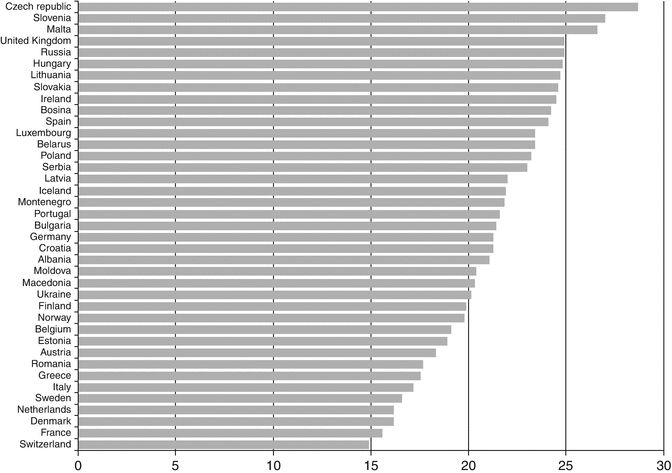Classification
BMI (kg/m2) general cut-off points
BMI (kg/m2) cut-off points for Asian populations
Underweight
<18.5
<18.5
Normal range
18.5–24.9
18.5–22.9
Pre-obese
25.0–29.9
23.0–27.4
Obese class I
30.0–34.9
27.5–32.4
Obese class II
35.0–39.9
32.5–37.4
Obese class III
≥40.0
≥37.5
2.3 Prevalence of Obesity Worldwide
The prevalence of obesity around the world is monitored by the WHO through the Global Database on BMI, which gathered data from surveys or population studies, where weight and height are measured or self-reported [9]. According to WHO database, 34.5 % of the world adults (age ≥ 20 years) were overweight and 11 % were obese in 2008 [9]. This means that in the world there were more than 1.4 billion overweight adults in 2008. Of these over 200 million men and nearly 300 million women were obese [9]. The prevalence of overweight and obesity was higher in women than in men (overweight: 35.1 vs. 33.8 %; obesity 14.0 vs. 10.0 %) [9]. Prevalence of obesity varies greatly across the WHO regions. Obesity is much more prevalent in the Americas (29.7 % in women and 23.5 % in men), in the WHO region of Europe (23.1 % in women and 20.4 % in men), and in the Eastern Mediterranean region (24.5 % in women and 13.0 % in men). Prevalence of obesity are lower in the WHO regions of Africa (11.1 % in women and 5.3 % in men), Western Pacific (6.8 % in women and 5.1 % in men), and South East Asia (3.7 % in women and 1.7 % in men). In all WHO regions women were more likely to be obese than men, and in the WHO regions for Africa, Eastern Mediterranean, and South East Asia, women had roughly double the obesity prevalence of men [9]. At a national level, the nations with the higher prevalence of overweight/obesity are represented by Pacific Islands (Nauru, Cook Islands, Tonga, Samoa, Palau, Kiribati), where the prevalence stands over 80 %. High-income Arabic Kingdoms in the Persian Gulf region (Kuwait, Qatar, United Arab Emirates, Saudi Arabia, and Bahrain) had overweight prevalence between 70 and 80 % and represents the second group of nations with the highest prevalence in the world. The only world three nations with a prevalence of overweight in 2008 lower than 10 % were represented by very poor low-income states (Bangladesh, Ethiopia, and Nepal) [9]. Besides ethnic factors, the economic levels play a crucial role in determining overweight/obesity prevalence worldwide. Indeed, the prevalence rates increase with income level of countries up to upper middle-income levels. The prevalence of overweight in high and upper middle-income countries was more than double that of low- and lower middle-income countries. For obesity, the difference is more than triple from lower middle-income countries to upper middle-income countries [9].
The USA has a high prevalence of overweight and obesity. The more recent US data are from the National Health and Nutrition Examination Survey, 2011–2012 [10]. According to this survey, more than one-third (34.9 %) of adults were obese. Prevalence of obesity was higher among middle-aged adults (39.5 %) than among younger (30.3 %) or older (35.4 %) adults. The overall prevalence of obesity did not differ between men and women. However, large racial differences were observed. The prevalence of obesity was higher among non-Hispanic black (47.8 %), Hispanic (42.5 %), and non-Hispanic white (32.6 %) adults than among non-Hispanic Asian adults (10.8 %). Among non-Hispanic black adults, 56.6 % of women were obese compared with 37.1 % of men [10].
In 2008, the general prevalence of obesity in the WHO region for Europe was lower (21.9 %) than the prevalence observed in the US (31.8 %) [9]. However, the prevalence of overweight and obesity varies greatly across the European countries, with countries having obesity figures closer to the US values and countries having much lower figures. The prevalence of obesity in European nations ranked according to the WHO levels in 2008 [9] is represented in Fig. 2.1.


Fig. 2.1
The prevalence (%) of obesity in adults in European nations, according to WHO database 2008 [9]
In Italy, prevalence of overweight according to WHO database was 49.2 % in 2008, and prevalence of obesity was 17.2 % [9]. These estimates are largely based on data collected by the Cardiovascular Epidemiologic Observatory of the Italian Health Institute (Istituto Superiore di Sanità – Progetto Cuore). A more detailed analysis of this database demonstrated an overweight prevalence of 50 % in men and 34 % in women. In the same sample, the prevalence of obesity was 17 % in men and 21 % in women [11]. Overweight and obesity prevalence was higher in the southern regions of Italy, where 19 % of men and 30 % of women were obese, and 52 % of men and 35 % of women are overweight [11].
Alarming prevalence of obesity has been observed also in children and adolescents in several countries worldwide. A study comparing data from large nationwide surveys, has shown that the combined prevalence of obesity and overweight in children was high in the USA (25 %), moderate in Russia (16 %), and low in China (7 %) [12]. In 2011–2012, the prevalence of obesity in the USA was 16.9 % in subjects 2- to 19-year-olds [13]. In Italy, 22.2 % of children in primary school were overweight and 10.6 % had obesity in 2012 [14]. Alarming data have been observed in the southern regions of Italy where more than 40 % of 6–10-year-old children were overweight or obese [14




Stay updated, free articles. Join our Telegram channel

Full access? Get Clinical Tree








